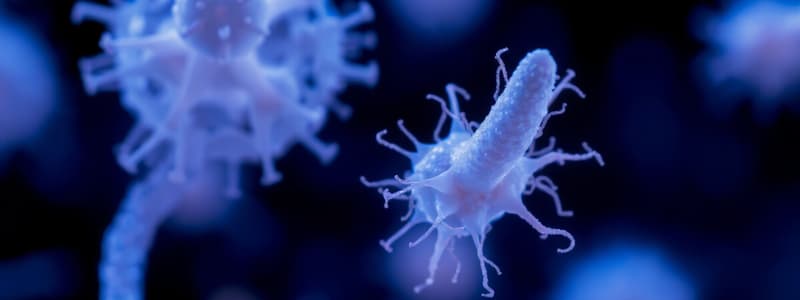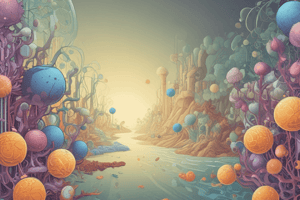Podcast
Questions and Answers
Which of the following is NOT a domain of life in which microorganisms are found?
Which of the following is NOT a domain of life in which microorganisms are found?
- Bacteria
- Archaea
- Eukarya
- Protista (correct)
All microorganisms are unicellular.
All microorganisms are unicellular.
False (B)
What is the primary structural difference between prokaryotic and eukaryotic microorganisms regarding organelles?
What is the primary structural difference between prokaryotic and eukaryotic microorganisms regarding organelles?
Prokaryotes lack membrane-bound organelles, whereas eukaryotes possess them.
The process by which some bacteria communicate and coordinate gene expression based on population density is known as ____________.
The process by which some bacteria communicate and coordinate gene expression based on population density is known as ____________.
Match the following microorganisms with their characteristics:
Match the following microorganisms with their characteristics:
Which metabolic strategy do autotrophic microorganisms utilize to produce their own food?
Which metabolic strategy do autotrophic microorganisms utilize to produce their own food?
Endospores are reproductive structures formed by all bacteria.
Endospores are reproductive structures formed by all bacteria.
How do nitrogen-fixing bacteria benefit plants, and what type of interaction is this?
How do nitrogen-fixing bacteria benefit plants, and what type of interaction is this?
If a newly discovered extremophile thrives in a highly alkaline environment, it would be classified as:
If a newly discovered extremophile thrives in a highly alkaline environment, it would be classified as:
Besides bacteria and some Eukarya such as fungi, Members of the domain __________ are known to form endospores that can withstand boiling, radiation, and chemical disinfectants.
Besides bacteria and some Eukarya such as fungi, Members of the domain __________ are known to form endospores that can withstand boiling, radiation, and chemical disinfectants.
Flashcards
Microorganisms (Microbes)
Microorganisms (Microbes)
Microscopic organisms existing as single cells or cell clusters.
Bacteria
Bacteria
Prokaryotic microorganisms; diverse shapes and metabolic capabilities.
Archaea
Archaea
Prokaryotic microorganisms, genetically distinct, often in extreme environments.
Eukarya (Microbial)
Eukarya (Microbial)
Signup and view all the flashcards
Ecological Roles of Microbes
Ecological Roles of Microbes
Signup and view all the flashcards
Extremophile Habitats
Extremophile Habitats
Signup and view all the flashcards
Autotrophic Microbes
Autotrophic Microbes
Signup and view all the flashcards
Heterotrophic Microbes
Heterotrophic Microbes
Signup and view all the flashcards
Binary Fission
Binary Fission
Signup and view all the flashcards
Endospores
Endospores
Signup and view all the flashcards
Study Notes
- Microorganisms, also known as microbes, are microscopic organisms that exist as single cells or cell clusters
- Microbes are very diverse and ubiquitous
- They are found in all three domains of life: Bacteria, Archaea, and Eukarya
- Many microbes are unicellular, but some are multicellular
Types of Microorganisms
- Bacteria: Prokaryotic microorganisms with a wide range of metabolic capabilities and diverse shapes (e.g., cocci, bacilli, spirilla)
- Archaea: Prokaryotic microorganisms similar to bacteria in shape and size, but differ in genetic makeup and often inhabit extreme environments
- Eukarya: Eukaryotic microorganisms, including protozoa, algae, fungi, and some parasites, characterized by membrane-bound organelles
Importance of Microorganisms
- Microbes play crucial roles in nutrient cycling, decomposition, and various biogeochemical processes
- They are essential for various industrial processes, including fermentation, antibiotic production, and enzyme synthesis
- Some microbes are used in bioremediation to clean up pollutants
- Certain microorganisms are vital for human health, such as gut bacteria aiding digestion and synthesizing vitamins
- Some microorganisms are pathogenic and can cause infectious diseases in plants and animals
Microbial Habitats
- Microbes are incredibly adaptable and can thrive in various environments
- They can be found in soil, water, air, and within/on plants and animals
- Some microbes are extremophiles, thriving in extreme conditions like high temperatures (thermophiles), high salinity (halophiles), or extreme pH levels (acidophiles/alkaliphiles)
Microbial Structure
- Bacteria and Archaea lack membrane-bound organelles, while Eukaryotic microorganisms possess organelles like mitochondria, chloroplasts, and nuclei
- Bacterial cell walls typically contain peptidoglycan, while archaeal cell walls vary in composition and lack peptidoglycan
- Some microbes have external structures like capsules, flagella, or pili that aid in protection, motility, or attachment
Microbial Metabolism
- Microbes exhibit diverse metabolic strategies
- Some are autotrophs, capable of producing their own food through photosynthesis or chemosynthesis
- Others are heterotrophs, obtaining nutrients from organic matter
- Microbes can be aerobic, requiring oxygen for growth, or anaerobic, growing in the absence of oxygen
- Fermentation is an anaerobic process used by some microbes to generate energy
Microbial Growth and Reproduction
- Microbes reproduce mainly through asexual reproduction, such as binary fission (bacteria), budding (yeast), or fragmentation
- Microbial growth is influenced by factors like temperature, pH, nutrient availability, and water activity
- Some bacteria can form endospores, which are dormant, resistant structures that can survive harsh conditions
Microbial Interactions
- Microbes can interact with each other and with other organisms in various ways
- These interactions can be mutualistic, commensalistic, or parasitic
- Quorum sensing is a communication mechanism used by bacteria to coordinate gene expression based on population density
Microorganisms and Disease
- Pathogenic microorganisms can cause infectious diseases by invading host tissues, producing toxins, or triggering immune responses
- Viruses are acellular microbes that require a host cell to replicate and can cause various diseases
- The study of microorganisms in relation to disease is known as medical microbiology
Beneficial Microorganisms
- Beneficial microorganisms such as nitrogen-fixing bacteria and mycorrhizal fungi promote plant growth
- They can be used as biocontrol agents to suppress plant diseases and pests
- Probiotics are beneficial bacteria that can improve gut health and immune function in humans and animals
Harmful Microorganisms
- Harmful microorganisms can cause spoilage of food
- They can degrade materials
- They can negatively impact the environment
Studying That Suits You
Use AI to generate personalized quizzes and flashcards to suit your learning preferences.




